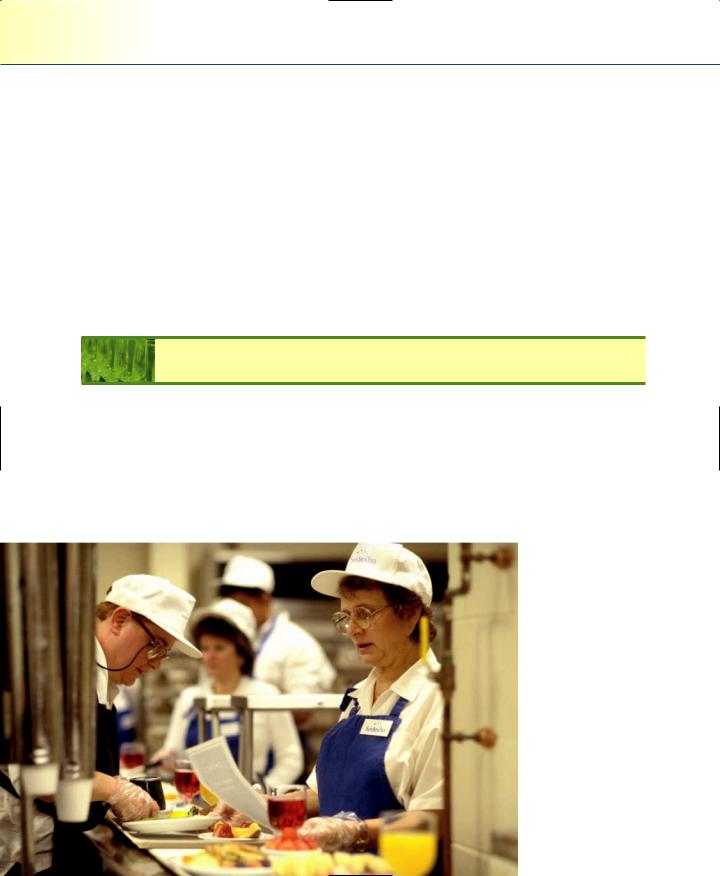
- •CONTENTS
- •PREFACE
- •Content—Benefits for Students
- •Content—Benefits for Instructors
- •Features of the Book for Students and Instructors
- •Supplementary Materials
- •Acknowledgments
- •What Is Hospitality Management?
- •The Manager’s Role in the Hospitality Industry
- •Why Study in a Hospitality Management Program?
- •Planning a Career
- •Employment as an Important Part of Your Education
- •Getting a Job
- •Employment at Graduation
- •The Outlook for Hospitality
- •Summary
- •Managing Change
- •Demand
- •Supply
- •Workforce Diversity
- •The Impact of Labor Scarcity
- •Summary
- •The Varied Field of Food Service
- •The Restaurant Business
- •The Dining Market and the Eating Market
- •Contemporary Popular-Priced Restaurants
- •Restaurants as Part of a Larger Business
- •Summary
- •Restaurant Operations
- •Making a Profit in Food Service Operations
- •Life in the Restaurant Business
- •Summary
- •Chain Restaurant Systems
- •Independent Restaurants
- •Franchised Restaurants
- •Summary
- •Competitive Conditions in Food Service
- •The Marketing Mix
- •Competition with Other Industries
- •Summary
- •Self-Operated Facilities
- •Managed-Services Companies
- •Business and Industry Food Service
- •College and University Food Service
- •Health Care Food Service
- •School and Community Food Service
- •Other Segments
- •Vending
- •Summary
- •Consumer Concerns
- •Food Service and the Environment
- •Technology
- •Summary
- •The Evolution of Lodging
- •Classifications of Hotel Properties
- •Types of Travelers
- •Anticipating Guest Needs in Providing Hospitality Service
- •Service, Service, Service
- •Summary
- •Major Functional Departments
- •The Rooms Side of the House
- •Hotel Food and Beverage Operations
- •Staff and Support Departments
- •Income and Expense Patterns and Control
- •Entry Ports and Careers
- •Summary
- •The Economics of the Hotel Business
- •Dimensions of the Hotel Investment Decision
- •Summary
- •The Conditions of Competition
- •The Marketing Mix in Lodging
- •Product in a Segmented Market
- •Price and Pricing Tactics
- •Place—and Places
- •Promotion: Marketing Communication
- •Summary
- •The Importance of Tourism
- •Travel Trends
- •The Economic Significance of Tourism
- •The United States as an International Tourist Attraction
- •Businesses Serving the Traveler
- •Noneconomic Effects of Tourism
- •Summary
- •Motives and Destinations
- •Mass-Market Tourism
- •Planned Play Environments
- •Casinos and Gaming
- •Urban Entertainment Centers
- •Temporary Attractions: Fairs and Festivals
- •Natural Environments
- •On a Lighter Note. . .
- •Summary
- •Management and Supervision
- •The Economizing Society
- •The Managerial Revolution
- •Management: A Dynamic Force in a Changing Industry
- •What Is Management?
- •Summary
- •Why Study Planning?
- •Planning in Organizations
- •Goal Setting
- •Planning in Operations
- •The Individual Worker as Planner
- •Long-Range Planning Tools
- •Summary
- •Authority: The Cement of Organizations
- •Departmentalization
- •Line and Staff
- •Issues in Organizing
- •Summary
- •Issues in Human-Resources Management
- •Fitting People to Jobs
- •Recruiting
- •Selection and Employment
- •Training
- •Retaining Employees
- •Staff Planning
- •Summary
- •The Importance of Control
- •Control and the “Cybernetic Loop”
- •Tools for Control
- •Summary
- •Leadership as Viewed by Social Scientists
- •Why People Follow
- •Leadership Theories
- •Communication
- •The Elements of Leading and Directing
- •Developing Your Own Leadership Style
- •Summary
- •A Study of Service
- •Rendering Personal Service
- •Managing the Service Transaction
- •How Companies Organize for Service
- •Summary
- •INDEX

540Chapter 16 Planning in Hospitality Management
and self-service salad bars. Once a company has established its policy on self-service, decisions on individual issues become clearer.
Companies often regard policies on unionization as especially important. Some companies set a goal of avoiding unionization and resist it by every legal means available, whereas others are indifferent to an organizing drive. A few companies actually encourage union representation. We take no position here on the pros and cons of a union. We merely point out that this illustrates how policy serves as a guide for action. In the three instances just cited, an incipient union-organizing drive would trigger three quite different reactions: a hurried and worried call to the home office, a yawn, or a friendly greeting.
As policies evolve, they call forth programs of action, strategies, and tactics to implement policy and achieve goals through action.
Planning in Operations
When management establishes goals and determines policies, its planning work has only begun. It needs a plan of action to specify how the policy will be implemented. Those two concepts borrowed from the military, strategy and tactics, distinguish between levels of plans. Strategy tells you where you want to go and why you
want to get there. Tactics deal with how to get there.
Operational planning is critical no matter what the setting. (Courtesy of Sodexho.)

Planning in Operations |
541 |
STRATEGIC ISSUES
Strategy concerns long-range basic plans. Our discussion will focus on examples in three strategic areas out of many that could be chosen: product and service strategy, human-resources strategy, and community relations. These three areas conveniently illustrate how policy guides decisions and is implemented by both planning and action.
Product and Service Strategies. In food service, a menu is a plan; the general pattern of an operation’s menus represents a strategy; and the customer you intend to reach dictates the strategy you will develop. Consider a steakhouse such as Steak and Ale. The menu reflects a policy of limited selection. This limited selection simplifies production and service. A strategy of self-service for salads represents a decision to give up portion control in return for the advantage of having the guests serve themselves. The advantages of the self-service are (1) the server has one less course to serve and
(2) the guests can eat salad while their steaks are being cooked. A server can carry a larger station, and so fewer servers are needed. Moreover, the guest begins to eat sooner, the wait between courses is shorter, and table turns are more rapid. With faster turns, a restaurant can serve more guests during peak meal periods. The trade-off for portion control on salads is more than worth the advantages gained.
In a similar vein, McDonald’s and other quick-service operators have chosen a menu strategy (developed a particular menu) that dictates most everything that takes place in their operation, from staff selection to layout and design. Similarly, the economy motel’s product and service strategy defines the market it will aim for, the kind of building it will construct, and the size of its staff.
Human-Resource Strategies. We will briefly examine two important personnelrelated issues to suggest the policies and strategies they dictate. Many companies wishing to avoid unionization use a compensation strategy that offers pay and fringe benefits well above union scale. In other cases, an aggressive compensation strategy may be adopted by a company not because of unionization but simply to help it hire the cream of the crop in its labor market.
Such a strategy dictates the rule that whenever the wage level in the local labor market rises, the company raises its wages. To follow this strategy, the company must initiate a procedure of regular wage surveys in the area.
Community Relations Strategies. Not surprisingly, different sectors of the hospitality industry court community favor in different ways. Let us look briefly at policy— and resulting strategy—in the commercial restaurant, hotel, health care, and school food service sectors.

542 |
Chapter 16 Planning in Hospitality Management |
The traditional way to offer the goods and services of a fast-food chain is to buy advertising in various media. Although a hotel or a local independent, high-quality restaurant may also purchase advertising, many of these kinds of operations rely more on public-relations activities. Thus, a local innkeeper may devote a great deal of time to public-service activities in order to build a favorable public image for the inn. This active public-relations strategy may differ from that of a nearby quick-service food operation that depends on advertising to bring the public through the door. The quickservice manager must spend his or her working time closely supervising operations; public relations may well be a minor part of the job.
In health care, it is usually just proprietary facilities that advertise, and even then, that advertising tends to be low-key. On the other hand, community hospitals actively involve themselves in public relations. Although they do not generally seek sales per se, hospitals do rely on periodic fund drives to raise capital for expansion or improvements. Thus, a favorable image in the community is helpful to them, too.
In recent years, the school lunch program has discovered that an active, interested group of supporters in the community can help them obtain the financial and moral support of the school board and school administrators. Consequently, a strategy of community involvement for school lunch managers dictates their being active with parent groups and other influential groups, especially those interested in nutrition in the community.
Each of these institutions—fast food, restaurant, hotel, hospital, and school lunch—needs financial support from the community in the form of sales, donations, or appropriations. Each has a policy of seeking community support, but their strategies differ according to the operational circumstances of each and the guests or clients they serve.
FROM STRATEGY TO TACTICS
Tactical issues are generally concerned more with short-range and localized actions. Like strategies, however, tactics are plans, the means of implementing policy.
In one high-occupancy chain hotel in a busy city, the property’s marketing strategy was dictated by its franchise affiliation. This affiliation attracted the middle-income traveler who wanted comfortable accommodations but could not afford a luxury hotel. The property’s downtown location gave it a special appeal to businesspeople. The manager realized, however, that a very large number of hotel rooms were being built in this market area. It became apparent that when all the properties under construction opened, the area would have an oversupply of rooms for several years to come. To prepare for this future marketing problem, the manager developed what was dubbed “FIRM Service.”

The Individual Worker as Planner |
543 |
A list of the largest firms in the area was compiled, and the hotel’s sales representatives’ work concentrated almost exclusively on these firms. At each of these firms, contact was established with one or more individuals who placed rooms business, and they were given a special number to call for reservations.
Furthermore, the manager instructed the front-office staff to hold a small number of rooms each day for FIRM Service accounts and to release them only as the house was filled. Only in exceptional circumstances was a FIRM Service request refused, and FIRM Service reservations were never “pulled” (canceled in the evening on the assumption the guest would not arrive).
The manager was too shrewd to assume that the property could keep business simply out of loyalty or gratitude; customers can be pretty fickle. What the manager did think—and rightly so—was that when the market became more competitive, the hotel’s sales personnel would be in a good position to reach key people at important accounts in the community. This tactic cost practically nothing, and it dealt with the problem of heavy future competition by gaining an advantage in that local market, which seemed most promising.
The Individual Worker as Planner
If an operation is to be successful, individual workers must begin to consider themselves as planners. Notice the planning that a server automatically engages in when moving from kitchen to dining room and back. As the server steps out of the kitchen, the server quickly sums up the situation in the station: One of the three tables (Table A) has just been seated. A second party has finished its main course ( Table B). A third party (Table C) is waiting for the dessert (which the server is carrying). The server’s priorities
might be as follows:
1.Serve dessert (Table C).
2.Greet and assure return while serving water (Table A).
3.Take dessert order (Table B).
4.Take appetizer and main course orders (Table A).
5.Return to kitchen.
As the server carries out this plan and heads back to the kitchen, she realizes that she also must plan her movements in the pantry to minimize wasted time and effort. On the way out of the dining room, she asks the busperson if he can clear Table B. With his assurance on that, she plans her moves in the kitchen:

544 |
Chapter 16 Planning in Hospitality Management |
1.Call dinner orders (for Table A).
2.Pick up appetizer (for Table A).
3.Pick up dessert (for Table B).
4.Return to dining room.
Her pattern is not necessarily the right way to handle a three-table station, and an actual situation would certainly not be this neat. The point is that a server relies heavily on planning, whether or not she is conscious of it.
When the head cook arrives at work at 8:00 A.M., she realizes that three meals confront her with immediate problems: Breakfast is now in progress and unusually busy. The short-order cook is in trouble because he’s running out of his setup (raw food stored in a nearby refrigerator). The turkey on the menu for dinner needs to come out of the freezer right away. A round roast has to go in the oven immediately to be ready for an early banquet.
A great many different steps, the cook realizes, must be taken later in the day, but these immediate matters are of pressing concern. She takes these steps in order of priority and with a view to saving time and effort:
She enters the walk-in with a cart, steps into the adjacent freezer (which can be reached only from the walk-in), and places the turkeys on the cart. Back in the walkin, she places the round on her cart. These actions delay her only a minute. Now she loads the bacon, sausage, and eggs the short-order cook needs and proceeds to the kitchen, giving the supplies to the short-order cook.
Her solution here may not be absolutely correct, but the incident should illustrate how essential planning is for that cook: Grab a cart so she can carry everything. Take one minute while she’s in the walk-in to get the two other things she needs from there. While she is there, solve the breakfast cook’s problem. It’s going to be a busy day, so she shouldn’t make three trips when one will do.
Not surprisingly, the hospitality industry rejects those management “experts” who assert that planning is exclusively a management function. Planning obviously pervades the well-run hospitality operation at all levels, from the housekeeper who checks the stock on his or her cart to the general manager who orchestrates all the planners he or she works with.
PLANNING AS A PERSONAL PROCESS
In Chapter 1, we discussed the notion of knowledge as retained earnings. We suggested that someone interested in a hospitality career can begin to accumulate useful learning experiences in the earliest, least-skilled jobs. Now it is time to reinforce that concept
